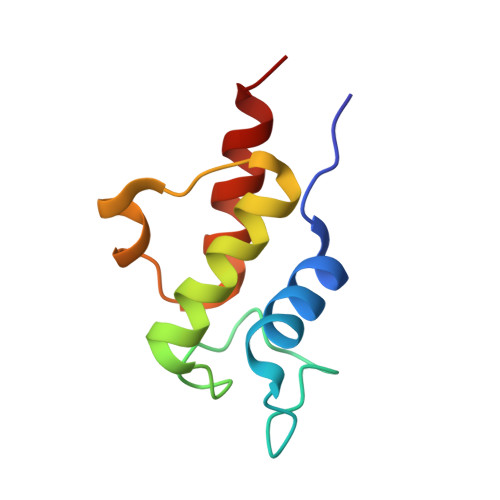Probing the Interactions of Early Polyketide Intermediates with the Actinorhodin ACP from S. coelicolor A3(2).
Evans, S.E., Williams, C., Arthur, C.J., Ploskon, E., Wattana-Amorn, P., Cox, R.J., Crosby, J., Willis, C.L., Simpson, T.J., Crump, M.P.(2009) J Mol Biology 389: 511-528
- PubMed: 19361520
- DOI: https://doi.org/10.1016/j.jmb.2009.03.072
- Primary Citation of Related Structures:
2KG6, 2KG8, 2KG9, 2KGA, 2KGC, 2KGD, 2KGE - PubMed Abstract:
Acyl carrier proteins (ACPs) are essential to both fatty acid synthase (FAS) and polyketide synthase (PKS) biosynthetic pathways, yet relatively little is known about how they function at a molecular level. Seven thiol ester and thiol ether derivatives of the actinorhodin (act) PKS ACP from Streptomyces coelicolor have been prepared and structurally characterised by NMR to gain insight into ACP-intermediate interactions. Holo ACP synthase has been used to prepare early-stage ACP intermediates of polyketide biosynthesis (holo ACP, acetyl ACP, and malonyl ACP) from the respective coenzyme A derivatives. A synthetic route to stabilised thiol ether ACPs was developed and applied to the preparation of stable 3-oxobutyl and 3,5-dioxohexyl ACP as diketide and triketide analogues. No interaction between the protein and the acyl phosphopantetheine moieties of acetyl, malonyl, or 3-oxobutyl ACP was detected. Analysis of (1)H-(15)N heteronuclear single quantum coherence and nuclear Overhauser enhancement spectroscopy spectra for the triketide ACP revealed exchange between a major ('Tri', 85%) and a minor protein conformer in which the polyketide interacts with the protein ('Tri(*)', 15%). Act ACP was also derivatised with butyryl, hexanoyl, and octanoyl groups. The corresponding NMR spectra showed large chemical shift perturbations centred on helices II and III, indicative of acyl chain binding and significant structural rearrangement. Unexpectedly, butyryl act ACP showed almost identical backbone (1)H-(15)N chemical shifts to Tri(*), suggesting comparable structural changes that might provide insight into the structurally uncharacterised polyketide bound form. Furthermore, butyryl ACP itself underwent slow conformational exchange with a second minor conformer (But(*)) with almost identical backbone chemical shifts to octanoyl act ACP. High-resolution NMR structures of these acylated forms revealed that act ACP was able to undergo dramatic conformational changes that exceed those seen in FAS ACPs. When compared to E. coli FAS ACP, the substrate binding pocket of the act PKS ACP has three specific amino acid substitutions (Thr39/Leu45, Ala68/Leu74, and Leu42/Thr48) that alter the size, shape, and location of this cavity. These conformational changes may play a role in protein-protein recognition and assist the binding of bulky polyketide intermediates.
- School of Chemistry, University of Bristol, Cantock's Close, Bristol BS8 1TS, UK.
Organizational Affiliation:

















